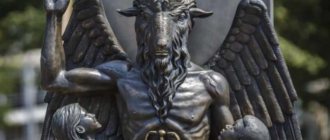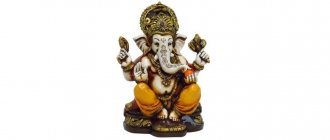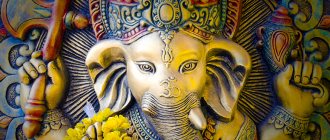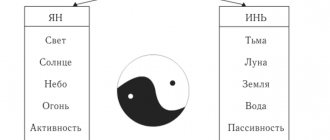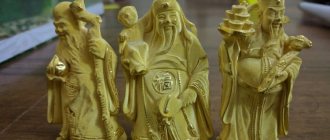Shiva God is one of the most famous and important deities in the Indian pantheon. Together with the divine Brahma and Vishnu, he makes up the famous Trinity of Hinduism - Trimurti.
It is believed that Brahma with Vishnu and Shiva are three hypostases of the One Supreme. Manifestations are associated with the Holy Trinity in Christianity, that is, the Father, Son and Holy Spirit. At the same time, Brahma acts as God the Creator, Vishnu as a protective force, and Shiva as a destroyer.
Shiva - a mysterious and two-faced deity
Find out what awaits you today - Horoscope for today for all zodiac signs
Due to numerous requests from subscribers, we have prepared an accurate horoscope application for mobile phones. Forecasts will arrive for your zodiac sign every morning - it's impossible to miss! Download for free: Daily Horoscope 2020 (available on Android)
Hinduism is a fairly widespread world religion. As the old legend tells, it is based on the customs of the Aryan peoples who inhabited Ancient India.
At the beginning of the 1st millennium AD, Hinduism split into two branches: Vaishnavism and Shaivism. The names come from the names of the deities to whom adherents of both religions prayed - that is, Vishnu and Shiva.
It is believed that the power of Vishnu and Shiva is equivalent, differing only in the direction of activity. While Vishnu protects the world, Shiva’s task is to destroy the outdated world so that something new can come into it.
God Shiva is engaged in the destruction of human illusions with which people love to please themselves. And although on the one hand he is angry, aggressive, unbridled, but on the other hand he is merciful, forgiving, capable of giving hope and his protection. Shiva fights evil demons. One day he wiped out 3 cities in which asura demons lived.
The sons of the demon Taraka influenced Brahma, and he allowed them to build three fortified cities. They created one on earth, one in heaven and another in the air, strengthened their abodes with evil spells, so that it was possible to kill them only with an arrow shot.
Evil entities felt their power and invulnerability, they wanted to destroy the light deities in order to take their place. Shiva burned down the cities of demons with one shot, ensuring the victory of good forces over evil.
According to legend, when a new stage in human life arises, Shiva creates it with the help of his dance. And with the completion of this stage through dance, it destroys what has already become obsolete.
The very first worshipers of Shiva are the Dravidians. The Dravidians were the very first people to live in India. Shiva gets the role of the main god in the Dravidian pantheon. They believed that Shiva controls everything in the world, because he managed to become absolute perfection, to prove himself at the highest quality.
Who does Lakshmi protect?
The many-armed goddess Lakshmi is a reliable support for those who are engaged in creativity and have connected their lives with this direction . She loves no less those who have found themselves in a profession related to the production of clothing or household items, cosmetology, finance, jewelry making, raising children, cooking, farming, and social assistance. Perhaps it is simply impossible to list all the areas of activity under the patronage of the goddess.
It is also worth remembering that Lakshmi can be both infinitely kind and merciful and angry - however, quite deservedly. She doesn't like it when people are too greedy and when, on the contrary, they waste too much money . If a person shows disrespect for food, has an unkempt appearance, there is dirt and strife with relatives in his house, conflicts at work - Lakshmi will turn away from such a person . She also does not encourage the killing of animals, poor treatment of natural resources, or the destruction of beautiful things.
Particular attention should be paid to wearing gold. If this is done incorrectly, luck, happiness and material well-being can turn away from a person. Since gold is one of the manifestations of Lakshmi and the Sun God (Surya), it must be treated with respect . You should not wear it on your ankles as a bracelet, as this part of the body is considered dirty. At the same time, the goddess does not limit the desire of both women and men to wear gold jewelry on any other parts of the body.
Lakshmi values courage, strength, the ability to withstand powerful opponents and win in the fight against them. The goddess patronizes people who are able to show determination.
The lotus-eyed goddess shows women by her own example how they should treat their spouses. They must honor their husbands as gods, remain faithful to them, always be wonderful housewives, attractive, and homemakers. At the same time, a grateful husband will surround his wife with care, attention, and give her what she wants.
Legends of the appearance of God
There are several versions of the arrival of the Divine Shiva in this world, each of which is different from each other.
- According to the first, Lord Brahma spent a lot of time in meditation, praying for a son like himself. As a result, a boy appeared on his lap, whose skin was an amazing blue color. The child began to run around the god, asking him to give him a name. Brahma nicknamed the baby Rudra, but this did not stop the boy - he continued to scream. Then Brahma was forced to come up with 10 more names, in total there were 11 of them, as well as 11 reincarnations.
- According to the second legend, Rudra (Shiva) was created by the wrath of Brahma, which is why this deity has the most negative energy in Hinduism.
- The third version claims that Brahma arose from the belly of Vishnu. Evil demons longed for the destruction of Brahma, and then from the area between Vishnu’s eyebrows, out of his anger, Shiva appears, holding the Trident in his hands, which saved Brahma from evil entities.
Attributes
Shiva has many different attributes. Wandering around India, you can notice completely different statues of the same gods. Knowledge of the symbolism of this country helps to understand all the nuances. Often in the hands of Shiva there are weapon attributes in the form of Ajagava (a special bow), Bhindipala (dart), Gada (rod), Khadga (sword), Khatvanga (club with a skull), Khetaka (shield) and various others. Another significant thing is Trishul’s trident (a symbol of evolution, gunas, three faces of time and other concepts).
Ritual attributes include:
- Chillum smoking pipe;
- Shankha shell;
- mudras (position of hands in special poses);
- a jug with the nectar of immortality Kaumudi;
- cup in the shape of a Kapal skull;
- small drum Damaru (symbol of the Universe from which everything around was born);
- Akshamala's special rosary.
Shiva is characterized by several energies: fire (Agni), the heavenly river (he was able to pacify the Ganga) and the power of Shakti.
The image of the deity is closely associated with animals: the snake Naga, the elephant and the tiger (the skins of these animals and the elephant goad), the white bull (Nandin) and the doe (Krishnamriga).
Shiva has special knowledge that can lift a person above this world and bring him closer to the Highest.
Attributes of Shiva
This deity is depicted with different symbols, which change depending on his incarnation. Attributes personify what is inherent in a particular reincarnation.
- The body of the Lord - naked, covered with ashes, symbolizes the source of the Universe, located outside the framework of earthly existence.
- Tangled curls represent spiritual, physical and mental types of energy.
- Ganga, who lives in curls, is one of the wives of Shiva. A stream of water falls from her lips and falls to the ground, which symbolizes Shiva’s elimination of ignorance, sins, the granting of peace, purity and knowledge.
- The moon in the god's hair represents that the mind can be controlled.
- Shiva is depicted with three eyes: the first is a symbol of the sun, the second is the moon, and the third is a symbol of fiery energy.
- The half-open eyes of God symbolize the endless flow of life, which has no end or beginning. It is cyclical and eternal. The opening of the eyes is associated with the beginning of a new round of life on earth. And their closure will tell about the destruction of the world necessary for a new birth.
- The snakes wrapped around the Lord's neck act as a symbol of the times - past, present and future.
- A necklace made of rudraksha (dried fruits of an evergreen plant) symbolizes divine inflexibility in controlling order in the Universe.
- The right hand, with which God blesses his followers, is associated with wisdom and is designed to destroy all evil and ignorance
- Trishula (trident) is a combination of three energies: knowledge, action and desire.
- The drum (dammaru) symbolizes the physical and spiritual forms of life.
- Nandi the bull, the eternal companion of the Lord, serves as his constant means of transportation.
- The tiger skin represents hidden energy, victory over one's passions.
- Shiva seated on the burnt ground symbolizes his control over the death of the physical body.
Image
This god is depicted in white, which signifies spiritual purity . The third eye can be seen in the middle of Shiva's forehead. With the help of it, he can see through space and time - this is a symbol of wisdom.
Another subtlety in the appearance of Shiva is the three stripes on his forehead . They are called tripunda (tripuṇḍraṃ).
One of the interpretations is this: they remind people that they should eradicate egoism (anava), get rid of karma (actions with a view to the result), and illusion (maya). Another interpretation of stripes is getting rid of unnecessary desires:
- at the bodily level, you cannot want to increase your life span, improve your health and appearance;
- on a spiritual level, you need to get rid of vanity, craving for a successful life and wealth;
- At the level of the mind, one should not accumulate unnecessary knowledge, become thoughtful, or experience pride.
Reference! This refers to the excessive focus of the mind in these directions.
For example, when people undergo surgery to look better. Too focused on wealth to the detriment of other areas of life. They gain knowledge only for the sake of knowledge, etc. Three white stripes in the image of Shiva (lingam with tripundra) also meant prisons in the human soul, these are the gunas - Sattva, Rajas and Tamas.
Later, the deity began to be depicted in a sitting or dancing form. One of the main variants of four-armed figurines was the image of Shiva with pale skin and a blue neck. His body is bent in the lotus position and is located on a fur mat; his shoulders are covered with elephant or tiger skin.
The third eye on the forehead is always open. One of the attributes of the deity was also a snake , draped over the shoulder, hanging on the neck or ringing the wrists and ankles. Shiva usually has different earrings in his ears: one for women, the other for men.
Another design of the figurine is Shiva in the form of a dancing deity. This is Nritya-Murti. The number of his hands is unlimited by a certain number. In his palms he can hold various attributes, both peaceful and military. A slain dwarf always lies at the feet of the dancing Shiva. It symbolizes the demon Alasmar-Purusha (illusion).
It is believed that this god lives in the mountains at the top of Kailash. It is there that he manages to immerse himself inside his world.
Shiva embodies severity, renunciation from the outside world. Thanks to the third eye, he comprehends the deep secrets of the Universe. With his palm facing the viewer, Shiva points to the path of liberation of the jiva (personal soul). He removes the shackles that hinder enlightenment.
Shiva's wives
According to legend, the many-armed god Shiva was married to three women: Sati, Parvati and Ganga.
- Sati is the first reincarnation of his wife. She was God’s beloved wife, but circumstances were such that she had to die prematurely by committing a ritual of self-immolation. Shiva suffered for a long time after the death of his beloved and carried her ashes around the world. To console him, Sati's soul decided to reincarnate as the daughter of the king of the mountains, who received the name Parvati.
- Parvati is by no means her only name. So, she is also known as Kali due to the fact that she was born black. Parvati had to woo Shiva and finally earned his love. God took her as his wife, and Parvati bore him two sons: Ganapati (Ganesha), the obstacle-removing god of wisdom, and Subrahmanya (Skanda), the leader of the warlike deities.
- Ganga is a goddess-river, but not an ordinary one, but flowing through three worlds - heavenly, earthly and underground. She is endowed with special power to relieve any earthly sins. Ganga developed strong feelings for Shiva and asked him to accept her. God married her, and from then on she dwells in his hair.
Holidays
One of the most famous festivals associated with the name of Shiva is Mahashivaramtri . This is the great night of the deity: festive festivities last throughout the night on the eve of the new moon on the last day of the lunar cycle of winter. This happens in February-March.
During Shivaratri, kathas (tales about Shiva) are read and hymns are sung in his honor. Festive events take place several times throughout the year, but this particular day is considered the most important, therefore the prefix Maha (great, main) is added to the word Shivaratri.
After the end of the holiday, the fair begins its work, taking place near rivers and reservoirs. Whoever was able to stay awake during the festivities will experience material well-being and a heavenly place in heaven.
Meditation on such a day brings a hundred times more benefits than on any other. This is related to the favorable placement of the Sun and Moon.
The symbol of the festive event is the lingam.
Shiva is known to many for his dancing image, so during the festivities everyone performs his Tandava. This is a special dance, considered a symbol of the movement of the world. Everything that exists is born from this dance and ends with it. While Shiva is dancing, the world exists. This god embodies the highest degree of bliss - Ananda.
Why do they turn to god Shiva?
It is logical to ask this question, because this deity is distinguished by its destructive power. But, on the other hand, God also destroys all ignorance, illness, everything that has outlived its usefulness and interferes with normal life.
In addition, translated from Sanskrit, the name Shiva means “good.” This god of the Hindu pantheon is responsible for the beginning of a new life, associated with flowering, fruiting, with life itself and sacrifice in its name.
He is also the only one of all the gods who controls time, in particular, human life. No one else is allowed to influence time except Shiva. Therefore, it is often called Mahakala - “great time”. Those who wish to extend the years of their earthly life, as well as to develop spiritually, should ask him for help in prayers.
Ancient legends say that God tried to prolong human life as much as possible. For this purpose, he gives people yoga, designed to lead to immortality and eternal youth. Then the gentlemen are called by another epithet - Mahayogi (Great Yogi).
Unfortunately, people were not able to immediately preserve the knowledge of yoga; over time, it was almost completely forgotten. But, fortunately, a few devotees of this art, hermits, helped yoga not to fall into oblivion, preserving asanas to this day. Today, physical and energy practice is actively being revived.
Temple
The city of Baijnath in India is famous all over the world for the temple of Lord Shiva. It was built in the thirteenth century and was named after one of the deity’s names – Vaidyanath, which translated means “patronage of healers.”
Once upon a time there was a shrine of Shiva in this place. The rich people of the city wished to perpetuate themselves in the memory of the people and created a new grandiose building on the holy place. These merchants' names were Ahuk and Manyuk. Nowadays, crowds of parishioners and tourists make pilgrimages to the temple.
The outside of the building is surrounded by a wall with two entrances. Shiva was depicted inside the structure as a multi-armed deity (lingam). It is interesting to note that the locals consider this image to be svayambhu (self-created). The walls of the temple are decorated with bas-reliefs of gods from the Hindu pantheon.
The entrance to the building opens with a statue of Nandi (white bull). According to legend, Shiva often rode a bull. The statue is a symbol of pure dharma, sincerity, devotion and courage.
What is the danger of a many-armed God?
By his nature, Mahadeva is dual: at the same time he acts as both a creator and a destroyer. At the end of its cycle, the Universe must be destroyed. But if Lord Shiva is angry, he can do this at any moment.
A similar thing happened when Sati died in a fire. Then God became bloody and cruel. He, experiencing the hypostasis of Virobhadra, reproduced himself in thousands of people and went to the palace of Sati’s father for retribution. In anger, he killed everyone around him and cut off the head of Daksha, the culprit behind the death of his beloved. Rivers of blood flowed across the ground, the sun became faded. But the god’s anger passed, and he resurrected all the dead, and Dakshi set up the head of a donkey.
Mantras, prayers and hymns praising Lakshmi
There are many prayers, stotras, hymns, slokas and mantras dedicated to the Indian goddess of wealth. The most famous Lakshmi mantra is: “ Om Hrim Shrim Lakshmi Byo Namaha .” It actually means “ Goddess Lakshmi resides within me and bestows abundance in all aspects of my existence .” But, there are a large number of other mantras with different meanings. Often people read a mantra without knowing its true purpose. But each of them has a specific purpose and effect.
The mantra “Om Lakshmi Vigan Sri Kamala Dharigan Swaha” helps those who want to find peace, fulfill their cherished desires, and improve their financial situation. For it to be as effective as possible, it should be repeated from April 13 to May 15, 108 times daily.
Audio
Children
The divine family acts as a form of Shankara, that is, consciousness called upon to create good for the world. Children from the union of Shiva and Parvati are the personification of the balance between the material and spiritual:
- Skandu (Kartikeya) is the god of war with six heads. His power is so great that already on the sixth day of his life he destroyed the demon Taraka.
- Ganesha, the elephant-headed god, is revered in India as the deity of material wealth.
- Narmada is the daughter of God, but in a not entirely traditional sense of the word. Thus, the Lord, practicing deep meditation on Mount Aramkut, separates from himself a share of his energy, from which the Narmada river is created. It is sacred to Hindus.
How to earn the favor of the goddess?
In order for Lakshmi to bring good luck, prosperity, love and mutual understanding to the house, various techniques are used.
The very first thing you need is to pay special attention to the home into which you want to attract the goddess . It is better if we place a figurine of Lakshmi or at least her image in the house. Since Lakshmi is interested in financial affairs and material well-being, and she herself does not tolerate inaction, it is best to place her image in the hallway or study. This is because these parts of the house have a connection with material wealth, financial wealth, and an increase in financial wealth. also advisable to focus on the southeast direction when placing the symbolism of the goddess . The southwestern direction is also allowed as the personification of travel and help.
Modern feng shui experts say that you can put a photo on the desktop of a computer device. It should depict the goddess with those symbols that represent your most pressing needs. There are enough necessary pictures and photos on the Internet.
You should do your best to stop quarreling and not keeping promises . Lakshmi loves when people take responsibility for their actions and take initiative . Special attention should also be paid to the cleanliness of the home. It is necessary to clean it as often as possible. You can periodically light incense sticks (ideally made from lotus and other flowers).
Goddess Figurines
To further appease Lakshmi, an altar should be installed and its surface covered with a beautiful cloth embroidered with gold threads. In its center there should be a figurine or image of this deity. The altar should be decorated with gold items, fresh large flowers, and precious stones (especially red and yellow jade, lapis lazuli).
Lakshmi is compassionate and merciful. She does not tolerate cruel, aggressive, envious and vicious people. therefore, in order to earn her favor, it is important to work on your spirituality.
Lakshmi will never stay where there is anger, hatred, lies, envy, hypocrisy and violence. She is also intolerant of sexual perversions, and therefore does not encourage non-traditional sexual orientations, accompanied by unhealthy hobbies, and the trade in intimate services. She simply leaves this place and does not want to return there anymore. And behind it goes prosperity, well-being, luck and happiness. Life in peace, love, harmony - that’s what she likes. And for this she generously rewards.
Female image of god
The left side of the deity's torso is associated with the feminine energy of Shakti. Shiva and Shakti are inseparable from each other. The goddess Shiva-Shakti, who has many arms, appears in the image of Kali - the deadly female incarnation of the destructive power of the deity.
Hindus worship the power of Kali. Her face can scare anyone: Kali has blue-black skin, a blood-red protruding tongue and a garland formed by 50 skulls (reincarnations).
One hand of Kali holds a sword, and the other holds the severed head of Mahisha (the leader of the demons). The other two hands express gestures of blessing to all followers, ridding them of fear. Kali is mother nature, who has the power to create and destroy everything in the world with great speed.
Finally, watch the video on the topic:
Ashtalakshmi
Ashtalakshmi (Ashta-Lakshmi) is translated from Sanskrit as “eight Lakshmi” . When this word is mentioned, they mean the secondary manifestations of the Indian goddess, which are represented by a group of female goddesses. These Indian deities are also called Lakshmi avatars. All of them symbolize various forms of well-being: offspring, power, prosperity, strength, knowledge, health . In honor of Ashtalakshmi, figures are created, decorated thematically, and hymns and printed images are dedicated to them.
Ashtalakshmi
Avatars of Lakshmi:
- Adi-Lakshmi (from Sanskrit means great Lakshmi) - this hypostasis is the daughter of the great sage Bhrigu. She is depicted with four arms. The lower hands show varada mudra (mercy, sincerity, compassion) and abhaya mudra (confidence, protection, fearlessness, calmness).
- Dhana-Lakshmi (Lakshmi, the giver of wealth) - symbolizes material wealth. In her six hands are a shankha, an akra, a bow and arrow, a jug of amrita, and a lotus. One hand demonstrates Abhaya mudra. She stands in red robes under a rain of sparkling gold coins.
- Dhanya-Lakshmi (Lakshmi of agriculture) is a symbol of fertility and patronizes agriculture. Six of her eight hands hold rice shoots, two lotuses, bananas, sugar cane, a mace, and two hands show abhaya mudra and varada mudra. This hypostasis of Lakshmi is dressed in green clothes.
- Gaja-Lakshmi (Lakshmi surrounded by elephants) - demonstrates power, patronizes animal husbandry. In two hands there are two lotuses, and two more hands show varada mudra and abhaya mudra. On both sides there are elephants who hold jugs of water in their trunks and water the goddess with it. According to legend, it was Gaja-Lakshmi who was able to return the wealth lost by Indra.
- Santana-Lakshmi (Lakshmi of offspring) - patronizes, protects families, helps to have offspring (primarily boys). In the image he has six arms. In two hands she holds jugs with amrita, in two more - a shield and a sword. With one hand she shows abhaya mudra, and with the other she hugs the boy sitting on her lap and holding a lotus in his hands.
- Vira-Lakshmi (courageous or valiant Lakshmi) - personifies courage, valor. It gives people strength and courage so that they can overcome difficult life obstacles. She is depicted in red robes and with eight arms. Holds a bow, arrow, shankha, chakra, sword or trident, Vedas (written on palm leaves). The two hands are folded in the varada mudra and abhaya mudra gestures.
- Jaya-Lakshmi (Lakshmi of success) - gives success in business, good luck and victory. Has eight arms. They hold a shield, sword, chakra, lotus, pasha, shankha, show varada mudra and abhaya mudra.
- Vidya-Lakshmi (Lakshmi of wisdom) - personifies knowledge and wisdom. First of all, he patronizes schoolchildren and students. Her eight hands hold a jug with amrita, shankha, bow, chakra, and demonstrate abhaya mudra and varada mudra. Traditionally dressed in yellow.
The cult of Ashtalakshmi originated in the 70s of the last century. This happened thanks to Vidvan Mukur Srinivasa Varada, a theologian of Sri Vaishnavism. He dedicated a hymn to Ashtalakshmi called "Ashta Lakshmi Strotam". Today this teaching is most widespread in South India.
The Adventures of Hanuman
Lakshmana and Rama entered into an alliance with the monkey king Sugriva to free Sita. Approaching the sea, it was decided to build a bridge. The devotee Hanuman, who had great strength, jumped over the strait to go in search of the woman. Finding her in Ravana's palace, he told Rama everything.
Having met the villain, Hanuman curled his tail into a spiral to create a seat noticeably higher than Ravana’s throne. This greatly angered him, and he demanded to kill the monkey. But he introduced himself as an ambassador, so his life was inviolable. Then Ravana ordered the servants to set his tail on fire and then let him go. Hanuman, with his tail on fire, began jumping from one building to another, spreading fire throughout the capital. Then he jumped back to the continent.
Historical reference
Hindu deities evolved from the Vedic era (second millennium BC) to the medieval era (first millennium CE). At the regional level - in India, Nepal and Southeast Asia. The exact nature of the belief regarding each deity varies between different Hindu denominations and philosophies. In total, there are 330 thousand such supernatural beings in various traditions.
The similarities between Kama and Cupid, Vishwakarma and Vulcan, Indra and Zeus lead many to the hasty conclusion that the gods of Indian mythology are similar to the Greek celestials. But Greek mythology is completely different from Hindu mythology. It reflects the subjective truth of the Greeks, who believed in polytheism.
Companion of Vishnu
As we remember, Vishnu came to earth 9 times in different avatars and each time his wife was Lakshmi, naturally, in her different incarnations. The most famous and revered are Sita (when Vishnu was Rama) and Rukmini (Vishnu - Krishna).
But no matter how they call her in one form or another, no one doubts that this is Lakshmi. Lakshmi emerged from the depths of the Comic Ocean along with other treasures, so many revere her as a divine treasure. She, like a true woman, is both the strength and weakness of her chosen one, which has been repeatedly reflected in folk art, for example in Ramayat. Often her image overshadows Saraswati, as well as Vishnu Brahma, and it is to her that the role of the Great Mother Mahadevi is shifted.
Lakshmi is traditionally depicted sitting on a pink or red lotus flower as a beautiful young woman, younger than Saraswati, wearing beautiful expensive clothes and jewelry. She usually uses a white owl as a means of transportation. She, like other gods, has four arms, but no obligatory objects that she holds can be distinguished. Sometimes she is depicted with lotuses, sometimes with gold coins - whatever the artist’s imagination allows. Lakshmi is incredibly popular in India because, in addition to being the wife of the supreme deity, she is also the patron of wealth, good fortune, luck, light, knowledge, wisdom, light, courage and fertility. She is a welcome guest in any home.
Surprisingly, but true, in order to earn her favor, the following actions, already familiar to us, are mandatory. The Goddess does not accept clutter, if your house is full of garbage, dust, unused things, do not expect her to visit you. The air in the house should be fresh, there must be water in a decanter, a house plant (if there is no garden), candles and incense. The most favorable area for placing the image of Lakshmi is the south-eastern part of the house. If you remember my post “How to attract money using Feng Shui”, then according to Chinese tradition, the wealth zone is located there, and the minimum measures to attract it come down to cleaning and ventilation. There is reason to think...
The offspring of Lakshmi and Vishnu is the god of love Kama. We have all heard a lot or a little about the Kama Sutra, and so, if translated literally, it means “the rules of love (lust).” By the way, poor Kama was seriously injured by the god Shiva, which brought upon the latter the serious wrath of Vishnu and Lakshmi. Kama fired an arrow of passion at Shiva when he was in deep asceticism and many years of meditation in order to attract his attention to the beautiful daughter of the king of the Himalayas, Parvati. This angered Shiva so much that he incinerated Kama with his third eye. Under pressure from Vishnu, Lakshmi and other gods, he was forced to agree to the rebirth of the god of love. Despite all his efforts, Kama was revived to life by ananga (incorporeal) and now he is everywhere.

